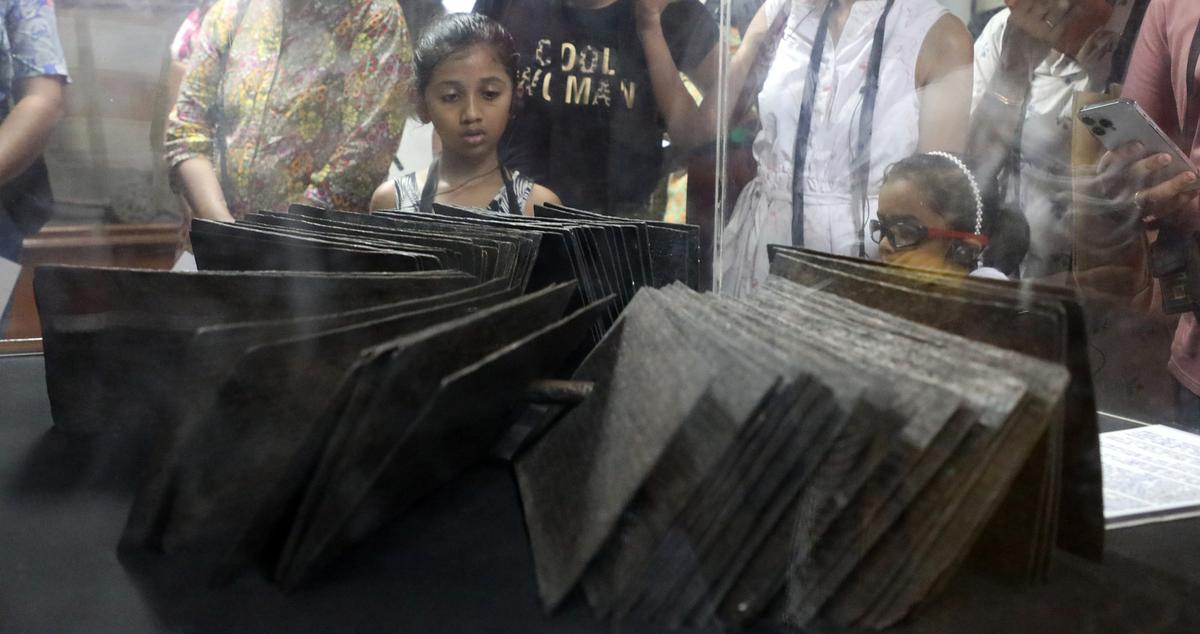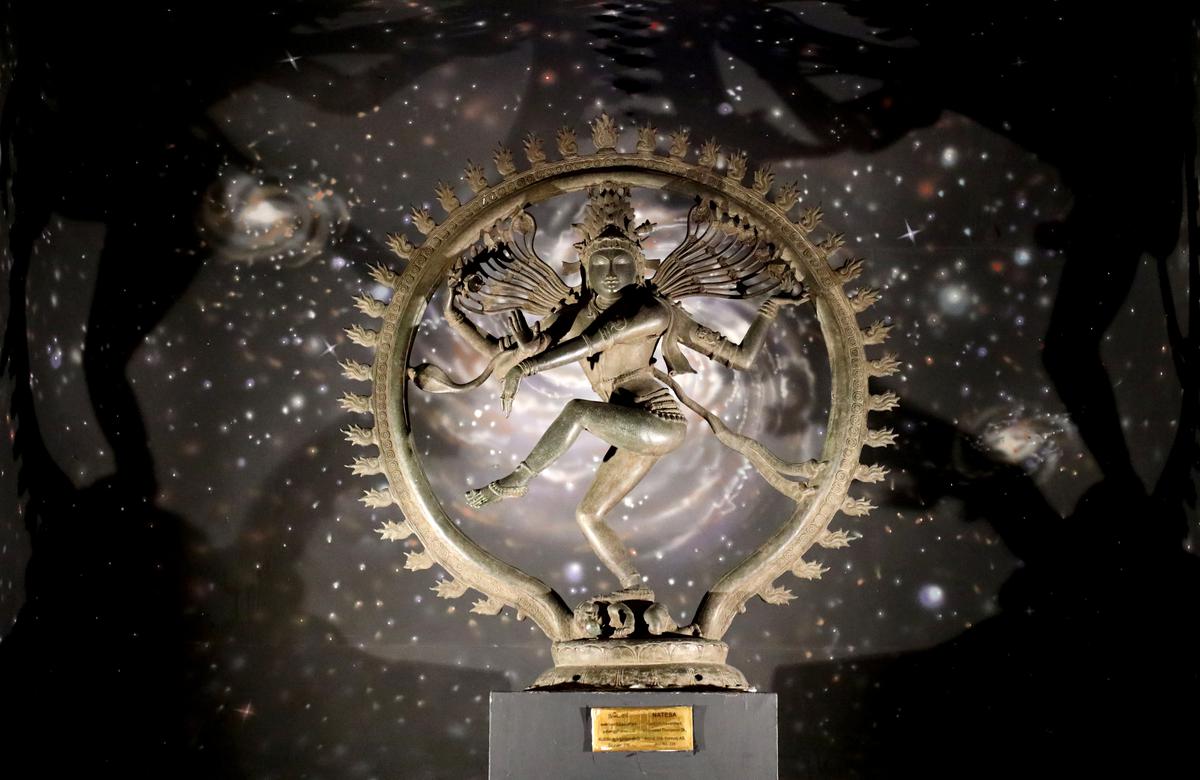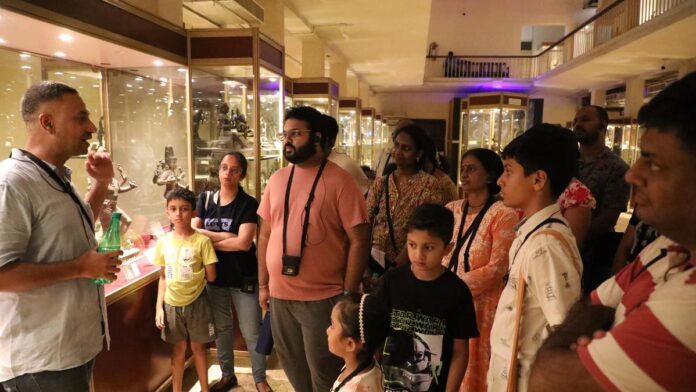
Chola craftsmen are masters in bronze, says Vijay Prabhat Kamalakara, the founder and CEO of Storytrails at the Egmore museum, Chennai during the Ponniyin Selvan-walk
| Photo Credit: Akhila Easwaran
Who killed Aditha Karikalan, the crown prince of the Chola empire? History is elusive and author Kalki leaves us hanging with no answers in his epic Ponniyin Selvan, tantalising the reader.
Vijay Prabhat Kamalakara, founder and CEO of Storytrails however, takes time to debate the possibilities during the second edition of the Ponniyin Selvan-inspired walk at Chennai’s Government Museum in Egmore last weekend.
“Who are the prime suspects?” he asks, standing before Chola copper plate inscriptions dating back to the 10th Century AD at the museum’s anthropology section.
Several eager hands shoot up, some mumble the answers — Uttama Chola, the man who unfortunately missed his opportunity for the Chola throne two times before getting his turn; Arulmozhi Varman or Raja Raja I who may have had a hand in killing his older brother to ascend the throne; or the Pandyas who felt dishonoured when Aditha Karikalan beheaded their leader, Veerapandyan, leaving his head on a pike.

Chennai, Tamil Nadu, 20 May 2023: For Metro Plus: Children seeing the Copper plate inscriptions of Chola dynasty kept in Egmore Museum on Saturday. Photo:Akhila Easwaran/ The Hindu.
| Photo Credit:
Akhila Easwaran
Vijay explains that a brief line in a stone inscription at Udayarkudi in Cuddalore, points to Soman, Ravidasan, Revadasa and Parameswaran — assassins hired by the Pandyas to avenge their king’s death. But he quickly follows it up with caveats. Aftera ll, a historian’s favourite answer is ‘It depends’, he says.
Deep dive
This Ponniyin Selvan walk by Storytrails that was curated after the release of director Mani Ratnam’s two-part film, explores several other such interesting bits of history. Attended by about 30 people across generations, the walk has historical takeaways for everyone.
A subset of Storytrails’ larger Egmore museum trail, this walk allows people to decipher fact from fiction, says Vijay. “Nandhini is just a character from the book,” he says, clarifying to a young participant.
We are taken through early Chola sculptures that are shaped out of massive blocks with little detail; their written scripts; hero stones that eulogise local heroes; the origin of the Bhakti movement; and intricate statues of Hindu gods at Egmore museum’s coveted bronze gallery.
“The walk connects the film and actual history seamlessly. It is a great starting point for children who are engaged for 90 minutes,” says Uma Viswanathan, a participant who brought her two children to the trail.
Lakshmi Shankar, head of operations at Storytrails, leads us to a gigantic Nataraja statue in the centre of the gallery and speaks about its connection to Sembiyan Mahadevi, mother of Uttama Chola and a significant character in Kalki’s Ponniyin Selvan.
She says that several bronze statues by expert Chola craftsmen portray Sembiyan Mahadevi as Parvathy, Lord Shiva’s consort, because of her devotion to the god. It was she who commissioned major Nataraja statues in Tamil Nadu’s major temples, she says.

Chennai, Tamil Nadu, 20 May 2023: For Metro Plus: Natarajar statue from the Chola dynasty kept in display at Egmore Museum on Saturday. Photo:Akhila Easwaran/ The Hindu.
| Photo Credit:
Akhila Easwaran
“Sembiyan Mahadevi is a good example of how Kalki viewed his characters. She is pious and a strong influence on three Chola kings— her husband Gandaraditya Chola, son Uttama Chola and grand nephew Raja Raja Chola or Arulmozhi Varman,” she says.
Vijay adds that Kalki, a staunch nationalist, was keen about exposing India to its rich history. He had excellent command over his mother tongue, Tamil and went on to serialise this seminal moment in history, making it hard to tell history from fiction, he says.
Their next walk is on May 28. For details visit www.storytrails.in for information.
#Discover #Chola #secrets #Ponniyin #Selvaninspired #walk #Chennais #Government #Museum
